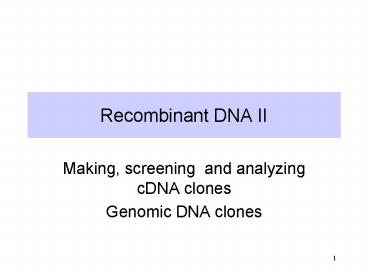Recombinant DNA II - PowerPoint PPT Presentation
1 / 20
Title:
Recombinant DNA II
Description:
Subtractive hybridization. Differential display ... Subtractive hybridization. mRNA *cDNA (radiolabeled) mRNA. anneal with mRNA in excess ... – PowerPoint PPT presentation
Number of Views:272
Avg rating:3.0/5.0
Title: Recombinant DNA II
1
Recombinant DNA II
- Making, screening and analyzing cDNA clones
- Genomic DNA clones
2
cDNA clones are copies of mRNAs
- Much of the genomic DNA is not expressed as mRNA
- Many issues about gene function are best
addressed by examining the product that they
encode. - The cDNA copies of mRNA contain primarily
sequences that encode protein. - Therefore, cDNA clones are useful for many
studies of gene function.
3
Construction of cDNA clones
- Use the enzyme reverse transcriptase to copy mRNA
into complementary DNA, called cDNA. This is
equivalent to the template strand of the duplex
DNA. - Use a DNA polymerase to copy that cDNA into the
nontemplate (message synonymous) strand. - Insert the duplex cDNA product into a cloning
vector and propagate in a host, e.g. E. coli.
4
cDNA first strand synthesis
5
mRNA
3
TTTTT
Anneal oligo-dT primer
Reverse transcriptase RNA-directed DNA
polymerase RNase H
dNTPs
AAAAAAA
3
TTTTT
5
Hydrolyze remaining RNA with base
5
Product is complementary DNA, called cDNA. It is
equivalent to the template strand of the duplex
DNA.
5
cDNA second strand synthesis
Problem How to get a primer for 2nd strand
synthesis?
cDNA
5
dCTPs
Terminal deoxynucleotidyl transferase
CCCC
TTTTT
5
5
Ligate an adaptor to the 3 end
3
5
CCCC
3
TTTTT
5
DNA polymerase
dNTPs
AAAAA
5
3
CCCC
3
TTTTT
5
Duplex cDNA
6
Ligate duplex cDNA into a plasmid
Duplex cDNA
5
3
AAAAA
CCCC
3
TTTTT
5
Restriction endonuclease
Cut the adaptor
GGGG
AAAAA
CCCC
TTTTT
Ligate duplex cDNA into a plasmid
Transform the population of cDNA plasmids into
bacteria. Result is a cDNA library.
7
Limitations of cDNA synthesis
- First strand synthesis often does not go to
completion. - Individual cDNA clones will frequently have the
reverse complement of only part of the mRNA. - Multiple cDNA clones from a single mRNA will be
present in the library - Priming second strand synthesis is inefficient
- Some methods necessarily result in the loss of
sequences at the 5 end of the nontemplate strand
8
How do you find a cDNA clone from the desired
gene?
- A cDNA library has gt100,000 individual clones.
- It contains copies of as many as 50,000 different
mRNAs . - The frequency of occurrence of a cDNA from a
given gene reflects the abundance of the mRNA for
that gene. - Try to find correct 1 clone in about 100,000.
9
Strategies for screening cDNA clones
- Brute force screen for abundant cDNAs.
- Hybridization with a gene-specific probe.
- Express the cDNA in the host cell (i.e. make a
functional protein product) - Specific antisera
- Labeled ligand to a receptor
- Assay for a function (complementation)
- Differential analysis
10
Screening by hybridization
11
Screening for an expressed product
12
Expression screening in eukaryotic cells
transfect
introduce cDNA plasmids into cells
Epo
Cell line that needs a cytokine (e.g. IL-3) to
grow. Has no Epo receptor, will not grow in Epo.
Expression library cDNA inserts in a vector that
will drive expression in eukaryotic cells
A transformed cell line that expresses the Epo
receptor will now grow in Epo without IL-3. The
plasmid with the Epo receptor cDNA can be
isolated from this cell line.
13
Differential analysis
- Instead of looking for one particular cDNA, look
for cDNAs from all genes whose expression differs
in the process under study - Differentiation from mesoderm to muscle
- Response to different nutrients
- Progression through S phase of the cell cycle
- Methods
- Subtractive hybridization
- Differential display
- Hybridization to massively parallel arrays of
cDNAs.
14
Differential analysis applied to muscle
differentiation
15
Subtractive hybridization
myocyte
10T1/2
mRNA
cDNA (radiolabeled)
mRNA
anneal with mRNA in excess
mRNA-cDNA duplexes cDNA mRNA
Should contain cDNAs for
Should contain cDNAs
all mRNAs in common
specific for cells
between the 2 cell types
differentiating into muscle
Repeat
mRNA-cDNA duplexes bind to
HAP column
a
column
few
cycles
cDNA mRNA elute
Use the labeled cDNA to
Is unlabeled, will
hybridize to a library of
not interfere with
cDNA clones from 10T1/2
subsequent
-derived myocytes
steps.
16
Differential display of RT-PCR products
- Make cDNA from all mRNA in the two different
cellular states (RT reverse transcriptase). - Use several sets of PCR primers to amplify a
representative sample of all the cDNAs. - Resolve those RT- PCR products on a gel.
- Find the products that are present in only one of
the two cellular states being compared. - Try to isolate the corresponding gene.
17
Massively parallel screening of high-density chip
arrays
- Once the sequence of an entire genome has been
determined, a diagnostic sequence can be
generated for all the genes. - Synthesize this diagnostic sequence (a tag) for
each gene on a high-density array on a chip, e.g.
6000 to 20,000 gene tags per chip. - Hybridize the chip with labeled cDNA from each of
the cellular states being examined. - Measure the level of hybridization signal from
each gene under each state. - Identify the genes whose expression level differs
in each state. The genes are already available.
18
Expression profiling using microarrays
19
PSUs microarray spotting robot
20
Find clusters of co-regulated genes
Yeast cell-cycle regulated genes, 2.5 cycles
Human genes expressed in fibroblasts in response
to serum
Yeast sporulation associated genes
Spellman et al, (1998) Mol. Biol. Cell 93273
Chu et al. (1998) Science 282699 Iyer et al.
(1999) Science 28383.































